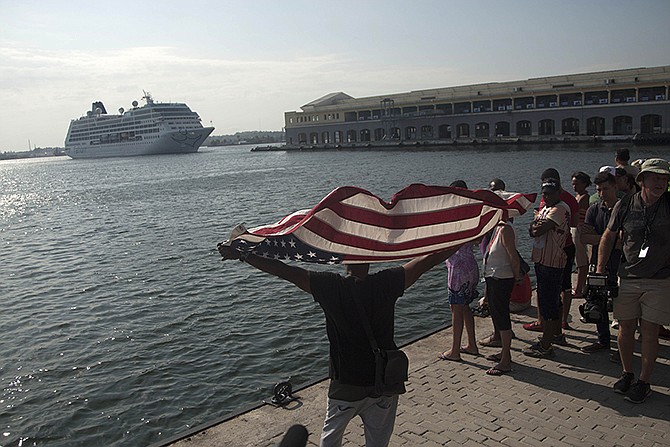HAVANA (AP) — Greeted with rum drinks and salsa dancers, the first passengers to cruise from the U.S. to Cuba in nearly 40 years streamed Monday into a crowd cheering the rebirth of commercial travel on waters that served as a stage for a half-century of Cold War hostility.
Many watching the festive arrival praised a Cuban government decision to drop a longstanding ban on Cuban-born people returning to their homeland by sea, a step that allowed 16 Cuban-Americans to make the journey from Miami.
“This is history,†said Mercedes Lopez, a 54-year-old nurse who waited for hours to see Carnival Cruise Line’s 704-passenger Adonia pull up to Havana’s two-berth cruise terminal. “We Cubans must unite, all of us. This is a step forward, a little step toward normalization, peace, family unification.â€
The passengers of the Adonia were welcomed by live music and dancing inside Havana’s single state-run cruise terminal. Outside, police carved a single lane into the crowd of hundreds of Cubans waiting in Old Havana’s Plaza San Francisco for passengers taking walking tours of the restored colonial center. The group included dozens of plainclothes security agents and hawkers promoting restaurants and souvenir shops, as well as many trying to witness history.
Cruise ships stopped crossing the Florida Straits from the U.S. after a brief window in the late 1970s when President Jimmy Carter allowed virtually all U.S. travel to Cuba. U.S. cruises to Cuba once again become possible after Presidents Barack Obama and Raul Castro declared detente on Dec. 17, 2014.
Both sides hope it is the first step toward a future in which thousands of ships a year could cross the Florida Straits, long closed to most U.S.-Cuba traffic due to tensions that once brought the world to the brink of nuclear war.
“I feel hopeful for the people of Cuba and for Cuba, hopeful that Cuba can realize its full potential,†said North Miami Beach City Manager Ana Garcia, who left the island nation in 1968 when she was 6.
Setting sail from Miami shortly before 5 p.m. Sunday, the Adonia took nearly 17 hours to cross the Florida Straits, steaming through a waterway blockaded by the U.S. during the Cuban Missile Crisis. Tens of thousands of Cubans have fled to Florida on homemade rafts in recent decades, with untold thousands dying in the process.
The number of Cubans trying to cross the straits is at its highest point in eight years, and cruises and merchant ships regularly rescue rafters from the straits.
U.S. cruises are expected to bring Cuba tens of millions of dollars in badly needed foreign hard currency if traffic increases as expected. More than a dozen lines have announced plans to run U.S.-Cuba cruises, and if all actually begin operations, Cuba could earn more than $80 million a year, the U.S.-Cuba Trade and Economic Council said Monday.
The Adonia will take eight days to circumnavigate Cuba and return to Miami. Part of the Fathom brand, the Adonia is one of Carnival’s smaller ships, roughly half the size of some larger European vessels that already dock in Havana.
Environmental scientists fear that if they’re joined by dozens more ships, there will be serious damage to an island that boasts the Caribbean’s healthiest marine life in large part due to decades without large-scale development.
“An influx of supersized ships in coastal waters of Cuba presents real risks to fragile coral reef ecosystems,†said Dan Whittle, head of the Environmental Defense Fund’s Cuba program. “Discharge of sewage into near pristine waters may degrade water quality and harm coral reefs and marine life.â€
Before the 1959 Cuban revolution, cruise ships regularly traveled from the U.S. to Cuba, with elegant Caribbean excursions departing from New York and $42 overnight weekend jaunts leaving twice a week from Miami, said California-based cruise ship historian Michael L. Grace.

